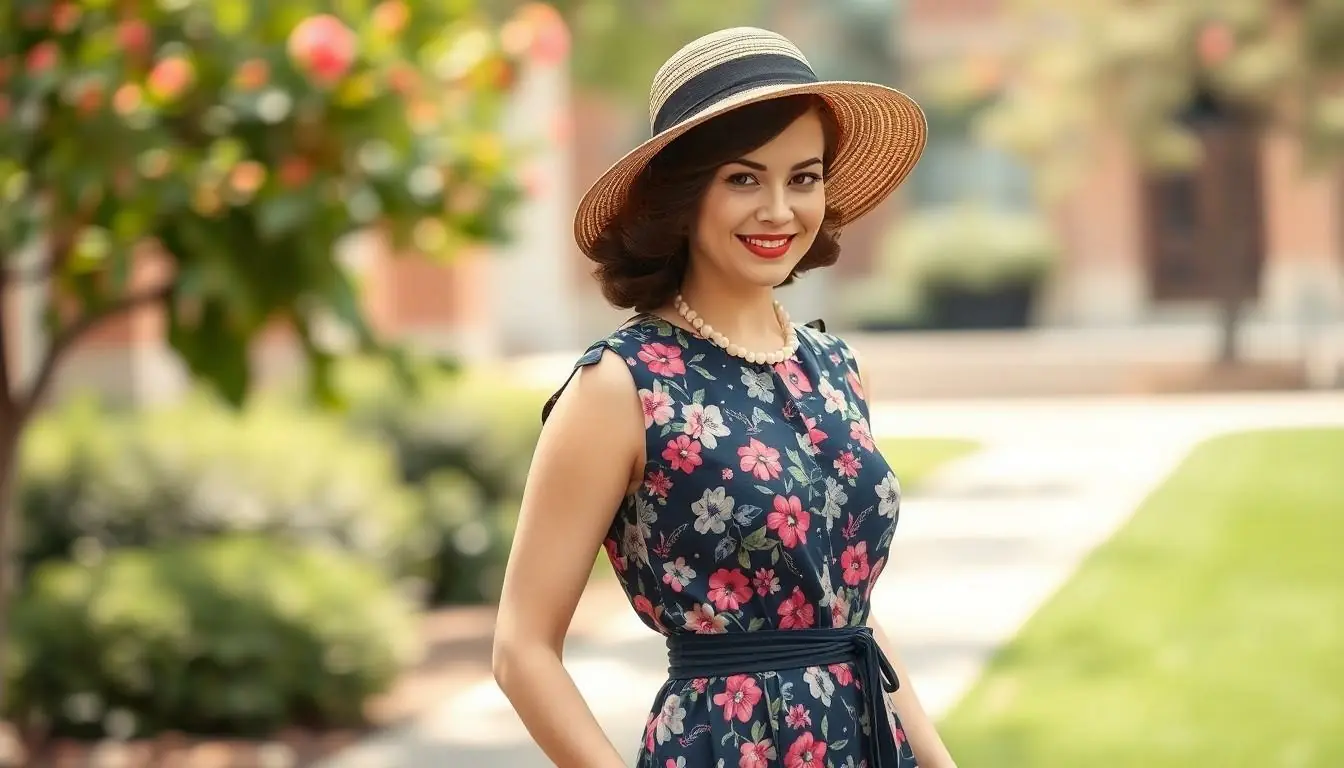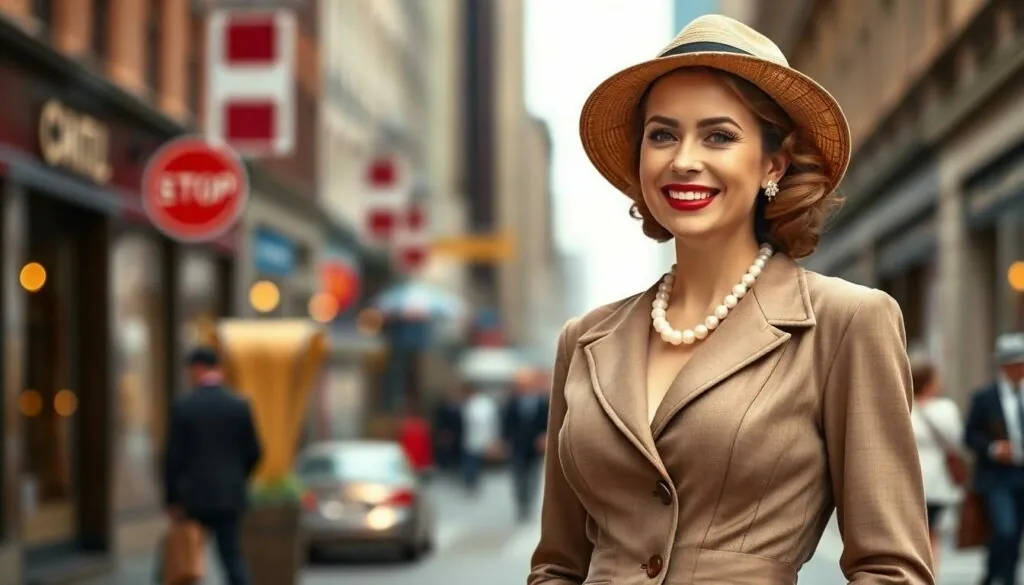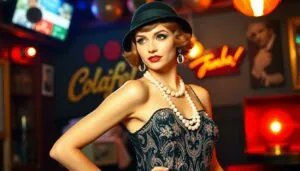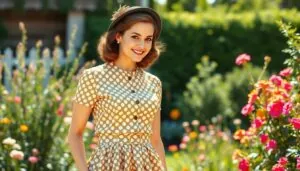Step into the time machine and zoom back to the 1930s, where women’s fashion was a delightful mix of glamour and practicality. This was the decade when women traded their flapper dresses for elegant silhouettes that hugged curves and celebrated femininity. Think of it as the time when style met substance—because who says you can’t look fabulous while navigating the challenges of the Great Depression?
Table of Contents
ToggleOverview Of Women’s 1930s Fashion
Women’s fashion in the 1930s showcased a remarkable evolution, moving away from the straight lines of flapper dresses to more structured and elegant silhouettes. Designers embraced fabrics like silk, rayon, and wool, creating garments that flattered the figure and enhanced femininity. Elegant evening gowns featured bias cuts, which draped smoothly over curves and added movement.
Simple daytime dresses reflected practicality and comfort while maintaining style. Designs often incorporated slight modifications like flutter sleeves and soft ruffles to express individual taste. Accessories such as gloves, hats, and pearls became essential elements of an outfit, contributing to the overall polished look women aimed to achieve.
Tailored suits emerged as a popular choice for working women, combining professionalism with style. Often, these suits featured jackets with defined shoulders and fitted skirts that hit just below the knee. The iconic “Hollywood Glamour” influenced public perception of beauty and fashion, drawing inspiration from film stars.
During this decade, color palettes shifted toward soft pastels and vibrant hues, offering a departure from the muted tones of the previous era. Floral prints and geometric patterns were routinely used, showcasing a dynamic flair. Furthermore, women found ways to navigate economic challenges through innovative styling and thrifty fashion choices.
The influence of art, particularly the Art Deco movement, reinforced bold lines and graphic designs in fashion. This era forever transformed women’s fashion ideals, reflecting their desire for sophistication amidst societal challenges. Styles from the 1930s continue to inspire fashion today, highlighting the decade’s lasting impact on women’s clothing.
Key Trends And Styles

The 1930s showcased distinct trends in women’s fashion. Fashion during this decade embraced elegance while reflecting practicality.
Daywear
Daywear featured simple, elegant silhouettes that emphasized comfort. Dresses often included cinched waists, accentuating the feminine figure. Fabrics like rayon and lightweight wool dominated. Sleeves varied from cap to long, providing versatility. Floral prints and bold geometric patterns added visual interest. Women paired their dresses with stylish accessories, such as wide-brimmed hats and gloves. Tailored blouses and pencil skirts emerged as popular choices, presenting a polished appearance for working women.
Evening Wear
Evening wear during the 1930s highlighted glamour and sophistication. Gowns featured luxurious fabrics, including silk and chiffon. Bias cuts became prominent, allowing dresses to flow gracefully while flattering the body. Deep V-necklines and intricate draping achieved a dramatic effect. Embellishments, such as sequins and beading, enhanced the visual appeal. Elegant evening wear often accompanied statement jewelry, such as long strands of pearls or chandelier earrings. This attire reflected Hollywood glamour, influencing women’s choices at social gatherings.
Sportswear
Sportswear in the 1930s focused on practicality and style. Comfortable materials gained popularity, enabling ease of movement. Women frequently wore tailored trousers and blouses for outdoor activities. Platform shoes and canvas sneakers became the footwear of choice, allowing for versatility. Swimwear evolved during this era, with one-piece suits featuring flattering cuts. This trend also included matching cover-ups for a chic beach look. Fashion adapted to accommodate the active lifestyle of women during this dynamic decade.
Influential Designers
Several designers significantly shaped women’s fashion during the 1930s. Their creativity and vision transformed clothing styles, setting trends that still resonate today.
Mainstream Designers
Popular designers like Elsa Schiaparelli and Coco Chanel played pivotal roles in this era. Schiaparelli introduced bold, surrealist designs, utilizing vibrant colors and unique prints. Chanel continued to redefine femininity, emphasizing simplicity with her iconic jersey dresses and tailored suits. Both designers created pieces that celebrated a woman’s form while ensuring comfort. Their influence extended beyond garments, impacting accessory trends that included hats, bags, and jewelry. Collectively, these designers shaped a new fashion narrative that merged elegance with practicality.
Avant-Garde Creators
Avant-garde creators such as Madeleine Vionnet and Jean Patou pushed fashion boundaries during the 1930s. Vionnet became renowned for her innovative draping techniques, creating modern, fluid silhouettes that enhanced movement. Patou focused on providing stylish sportswear, combining comfort with functional design. He popularized the “flapper” style, integrating sports elements into women’s fashion, which encouraged an active lifestyle. These designers redefined norms, demonstrating that fashion could serve both artistic expression and practical needs, allowing women to embrace their identities authentically.
Fabrics And Materials Used
Women’s fashion in the 1930s utilized a variety of luxurious fabrics and materials, emphasizing both elegance and comfort. Silks, rayons, and wools dominated this era, allowing designers to create beautiful garments tailored to each woman’s shape.
Popular Textiles
Silk became a favorite for evening wear, showcasing its lustrous quality in flowing gowns and draped silhouettes. Rayon emerged as a cost-effective alternative, mimicking silk’s properties while providing more accessibility during the Great Depression. Wool also saw significant use in tailored suits and practical coats, offering warmth without sacrificing style. Linen occasionally appeared in summer dresses, delivering breathability and a relaxed feel ideal for warm weather.
Patterns And Colors
Patterns in the 1930s varied widely, with florals and geometric designs gaining popularity for daywear. Bold geometric prints emerged prominently on dresses, while floral motifs adorned casual outfits. Color palettes included pastels and jewel tones, providing ample choices for various occasions. The influence of Hollywood glamor led to the use of vibrant shades, enhancing the luxurious feeling of evening gowns. Women showcased their individuality through color and pattern, reflecting the decade’s overall creative spirit in fashion.
Impact Of The Great Depression
The Great Depression drastically influenced women’s fashion in the 1930s. Economic hardship led to a shift in priorities, with women favoring practicality and affordability in their clothing choices. As disposable income dwindled, many sought stylish yet budget-friendly alternatives.
Women began to focus on versatile wardrobe pieces that could transition from day to night. Simple silhouettes became popular, allowing for comfort without sacrificing style. Fashionable dresses often featured clean lines and modest cuts, catering to a more practical lifestyle.
Designers responded to the demand for affordability through innovative fabric choices. Rayon emerged as a cost-effective substitute for silk, offering a luxurious feel without the high price tag. Wool remained a staple in tailored suits and outerwear, providing warmth and durability during tough economic times.
Accessories gained importance as means to elevate simple outfits. Gloves, hats, and pearls could transform a basic dress into a polished ensemble, enabling women to express their individuality. Tailored suits appealed to working women, blending professionalism with feminine aesthetics.
Hollywood’s glamour also left a mark on 1930s fashion despite economic constraints. Film stars like Bette Davis and Joan Crawford inspired trends that emphasized elegance, prompting many women to emulate their styles with modest adaptations. This influence reinforced the idea that glamour could be accessible, even during difficult times.
Essentially, the Great Depression molded a more practical approach to women’s fashion while maintaining style and elegance. Women navigated the economic landscape with creativity, showcasing resilience through their fashion choices.
The 1930s marked a pivotal moment in women’s fashion, blending elegance with practicality amid challenging times. This era showcased a remarkable transformation, where designers crafted garments that not only flattered the figure but also catered to the evolving roles of women in society.
The influence of Hollywood glamour and innovative fabrics allowed women to embrace their individuality while prioritizing comfort and affordability. As they navigated the complexities of the Great Depression, their fashion choices reflected resilience and adaptability.
The legacy of 1930s fashion continues to inspire contemporary styles, reminding us that even in adversity, women can express their strength and beauty through their clothing.




